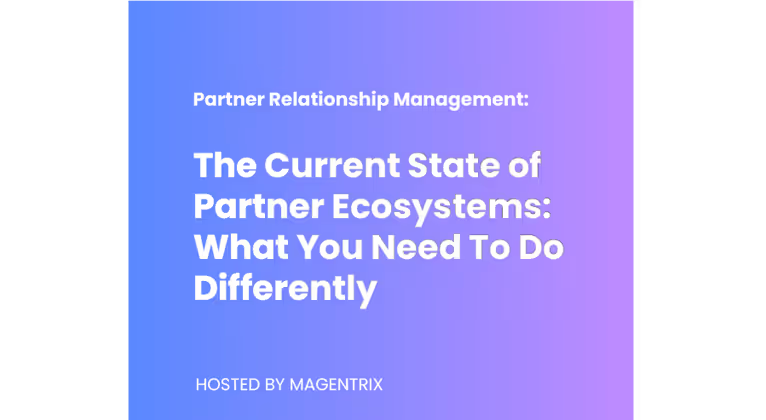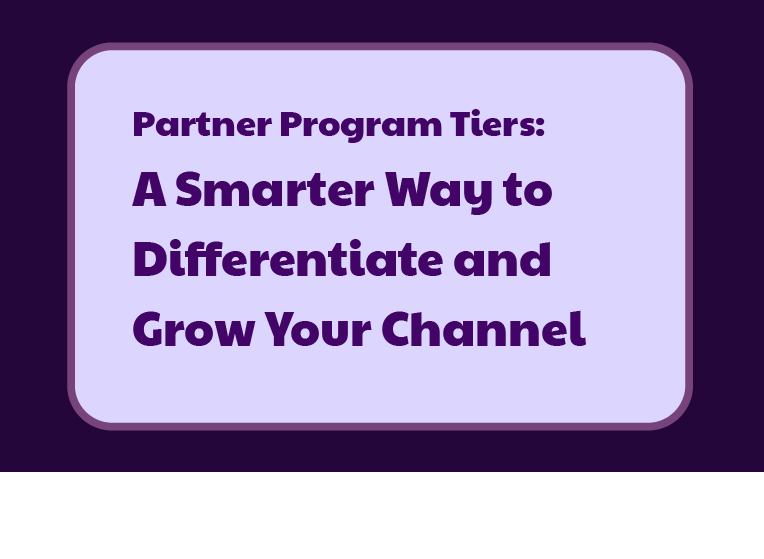- Introduction
- The current state of partner ecosystems
- Noticeable trends in partner ecosystems
- Common missteps channel teams make when executing an ecosystem approach
- How to thrive in the age of partner ecosystems
- What is a partner stack?
- Does collaborating with competitors benefit a partner ecosystem?
- Will the Chief Ecosystem Officer replace channel chiefs?
- Defining partner ecosystem KPIs and metrics
- The benefits of adopting a partner ecosystem model
- Balthasar Wyss’s background in channel
- About MeridianLink
The Current State of Partner Ecosystems: What You Need to Do Differently
How ecosystems affect the channel and what channel leaders can do differently in the ‘age of ecosystems’.

Table of Contents 📋
January 12, 2023
The Ultimate Channel Sales PodcastTable of Contents 📋
Listen to the podcast with guest speaker: Balthasar Wyss of MeridianLink. Aired on January 5, 2023.
In the past year alone:
- “Partner ecosystems” has become the hottest buzzword in the channel space
- Forrester reported an even split between "channel, direct, and marketplace revenue"
- And that 90% of IT sales will be partner-assisted before, during, and after a sale
All this to say that the channel looks shockingly different than it did just five years ago.
If a vendor’s channel team fails to jump on this partner ecosystem trend, will they be left behind?
Today, we’re going to:
- Look at how ecosystems affect the channel
- And what channel leaders can do differently in the ‘age of ecosystems’
Today's guest brings years of business development experience and wisdom from around the globe, and from both sides of the channel. He has decades of experience building channel and partner ecosystems.
Previously, he served as the Director of Channel Strategy and Partner Marketing for Microsoft and holds a Ph.D. from the University of Zurich.
Today he’s Vice President of Customer Success at MeridianLink, a digital lending platform. He's here with us today to talk about the current state of partner ecosystems and what you need to do differently.
Paul Bird: Let’s set the stage for today's topic: The evolution of partner ecosystems. What does today's channel ecosystem look like to you?
Balthasar Wyss: I see a number of trends, but before we get to the trends, maybe can talk a little bit about the status of the channel, as I see it.
And the first thing I would say is, you see a lot of companies going opportunistically after this and not always intentionally.
To give you an example, when you are a startup, the first thing you want to do is make sure you integrate into all the platforms.
So what do you do? You build an API and then integrate it.
“You tend to go opportunistically about those first partners. We're not thinking about what else those partners could do with this technology and what we can do with the integration partners.”
If you're more on the sales side and in a sales-lead company, you might also go opportunistically, just by signing up a few channel partners who give you leads.
That's not just a startup. If you think about Amazon, in the very early days back in the ’90s, they started with an affiliate network.
You could literally put a button on your website. And if somebody clicked on it to buy a book or a CD back then, that's what Amazon was about.
You got a little commission if the purchase went through.
Amazon essentially used affiliates (hundreds of thousands of affiliates) to generate sales. In some ways, very opportunistically, even a big company like Amazon was not necessarily always very intentional.
And the question is why?
I'd say one thing is, companies often are either product-led or sales-led. They don’t necessarily start with a partner in mind first.
They just said, hey, I have a great product I need to integrate. Or I have a fantastic go-to-market sales engine. How did you generate more of that?
The second thing I'll say is that partner function can be at times to be a bit misunderstood. It's either just seen as an integration play, or revenue play, and sometimes a necessary evil.
So I think it's important that we understand the function of what you can do with the potential of a partnership.
And the last thing I want to mention is short-term thinking. For example:
- We need to close the quarter
- We need to have more revenue coming in
What we need to do is think long-term about building a sustainable ‘partner moat’ that lets us build a company over the long term.

Paul Bird: So, what are some of those noticeable trends that you're seeing in the ecosystem space?
Balthasar Wyss: There are a number of them.
First trend: Expanded scope within partner organizations
First of all, I'd say,
“Partner organizations today have a more expanded scope. Rather than just being a lead source or a source for integration, partners and customers can be sold off along a whole life cycle.”
- Partners can be used in the discovery process
- Customers or prospects discover your solution
- Partners vet and evaluate your solutions
- And then along with the process of closing a deal is co-selling
- And enabling a great purchasing experience
- And then a fantastic post-sales experience, where the partner will take on certain things, like the ongoing management, or maybe even the renewal.
That's one of the trends: an expanded scope of partners and channel function.
Second trend: Broader variety of GTM models
Related to that, there's now a broader variety of go-to-market models:
- Selling with partners
- Selling to partners
- Partners integrating your solution
- Resell packages
Third trend: Broader business model differentiation
Then related to that, there’s a broader set of business models, i.e. simple MDF funds and market development funds. This could be:
- Commission-based
- Bounties
- Revenue share
- Ongoing subscription models
- Or an OEM license if you integrate it into a bigger platform
- And so on
So, a broader business model differentiation, if you will.
Fourth trend: More bidirectional relationship between vendor, channel & ecosystem
“The last thing where this all sort of comes together is the relationship between the vendor, and the channel, and the ecosystem becomes more bidirectional.”
It's not just hey, put that bottom up on your website and then, at the end of the day, we'll give you a few dollars if somebody buys a book from us. It's deeper.
For example, partners can help a vendor to understand their prospective customer base, to help them get a strategy, how to deploy it, and all those kinds of things.
It’s no surprise more people started talking about partner ecosystems or the Chief Ecosystems Officers recently.
Paul Bird: You mentioned Microsoft. I worked for a couple of Microsoft Gold Partners, pre-co-sell.
It was left to us, as the reseller, to take discovery through to closure.
I can think of some, you know, sizable opportunities that I was involved with where a co-sell model would have brought more authority and probably moved the deal along a lot quicker.
It's interesting that you notice that trend towards more co-sell.
I saw it on the other side when I worked in the channel because it became a little bit more difficult to onboard all of our staff to educate them, teach them, and get them to produce revenue.
It looks like that co-sell model really did work out for Microsoft.
Balthasar Wyss: Even before, they had the co-sell model around 2008- 2010 when the cloud became big, we really had to disrupt our channel.
Before you had software licensing models. Partners would get three years upfront, or cuffed at a fairly high percentage on a three-year license model to the end customer.
And then the cloud came and things changed radically. Microsoft is one of the most channel and partner-oriented organizations.
We have to bring over 100,000 partners into a new world of the cloud, with new engagement moments.
It was very disruptive. I mean, look at distributors – what is the role of a distributor today versus what it was 15 years ago? 15 years ago, they had warehouses and the software was on CDs, and books from Microsoft. That's not the real world today in the cloud; things changed dramatically with the cloud.
Paul Bird: When we first met you mentioned it's important to look back at our past in order to move forward.
So, is that the thought behind it? Is there anything else from the past that you'd recommend channel chiefs pay attention to?
Balthasar Wyss: I always think it's helpful, whether that's in your personal life or your business life, if you put things into context, take a step back and ask, where are things today?
What is different from maybe 10 years or 20 years ago? And what might happen in the next five years? Building context is helpful.
“The theme that I think is critical is working backward from the customer. Ultimately, what is the customer experience? And, how do partners drive customer experience? And that leads then to the next question: What kind of partner experience, do you want to provide?”
Is this just, you gave me a lead and I'll give you a bounty engagement? Either have:
- A simple, straightforward, commercial arrangement
- Or try to understand each other's strategy so that you really build engagements with partners.
And, understand the partner experience.
- What are they going through?
- What do they need to be successful? And so on.
With the expanded scope of partners and expanded scope and engagement with partners, the partner experience becomes much more important.
Paul Bird: As we look at the future of partner ecosystems, and the changes we need to make, what are some of the common missteps that you think channel teams might make when they're executing their ecosystem approach?
Balthasar Wyss: The first thing I always see, is that partners are often seen very tactically. Very narrow. Often I need some integration because my customers use all the partner systems as well. Or, I need to grow my revenue, so let's sign up a few partners who can bring new leads.
I think what's really critical going forward, is to think more strategically about how do you build a partner moat?
1. Not building a ‘partner moat’
Balthasar Wyss: I used to work at Avalara, which does tax compliance. It is a company extremely focused on channel.
Early on, Avalara built an incredible partner channel. We looked at this as building a moat. Not just to enable integration.
We realized, ll these transactional lenders could also be our go-to-market partners. What kind of engagements do we want to give them so that people or companies pick Avalara?
And we did a really quick approach and strategy that was very well thought through. The outcome was this we outgrew the competition massively.
When I joined around 2013, we were a third of the revenue of the market leader. When I left, we were over two times as big as the market leader. We completely outflanked the competition, because we went strategically about building a sustainable partner ecosystem; we had a big partner moat; it was very difficult for anybody else to break into that system.
2. Building a partner ecosystem around a product
Balthasar Wyss: A product may be a moat for a period of time. But very few companies build a moat with a product. Google might be one of the exceptions, for example, with their search engine. They are so far ahead of everybody else, including what they do now with artificial intelligence.
But over time the product is not necessarily a moat. All other companies can innovate.
For example, I worked at Netscape, Realnetworks, and Dell – all arguably better products compared to Microsoft. But those companies got out-competed by Microsoft because they had a better business model.
Product is not a sustainable moat.
Partners can be a sustainable moat if you:
- Do it the right way
- Provide a great partner experience
- Are rightful to use partners.
Over time it can be a competitive differentiator compared with other companies and competitors.

3. Not segmenting partners
Paul Bird: So as you talk about this makeup of your partner ecosystem, one of the things that people have always said is that you have to be able to identify and recruit the ideal partner.
So how do you approach an ecosystem where you may have so many different types of partners filling that partner moat?
Balthasar Wyss: That’s where segmentation comes in. There are multiple segmentations that need to happen, in my mind.
So first, what are you going to do? That goes back to the comment about starting with the customer experience.
A) Segment by buyer journey
What's the buyer journey? In the enterprise space, it's completely different than in the mid-market, or at the lower end.
I'll get back to that in a second, but that's just one of the segments.
B) Segment by geography
The other way you can go is obviously geographically.
Let's say you start your company in Canada, where you are based. How do you expand?
Do you build a beachhead with partners and then validate your model? Or do you go into Asia and Europe and other parts of the world as in geo-segmentation? How do you tackle that?
C) Segment by partner type
And then the third thing that comes to mind is segmenting by partner type. What kind of partners do you fundamentally need to be successful?
On the technology side, do you need to integrate with a lot of different systems? What kind of partner types do you need on the technology side or on the sales and marketing side?
I think it's important that you understand the environment in which you're operating. Ultimately, where your customers are.
Paul Bird: In my background managing channel, we basically did our channel management locally in Canada and the U.S.
And then we used value-added distributors (VARs) globally, so we could spread our footprint.
And that was a model that really worked for our software platform: to be able to have that kind of regional representation and give people the ability to get localized support and things like that.
So I guess that was kind of an early ecosystem, 20-plus years ago.
4. Not mapping out a partner ecosystem
Balthasar Wyss: What I always recommend people do, is build a channel or a partner ecosystem map. Map it out.
- How do partners get the customer?
- How do customers purchase?
- How do customers and partners get trained?
- How do they engage differently in other parts of the world?
- What do they need in terms of the products and services that you offer?
- Is it just a simple integration?
- Or do they need more than that?
“Build an ecosystem map and update it on a regular basis. You might expand your product or services, they might shift in a different direction, or your audience might shift.”
How to map a partner ecosystem
If I go back to Avalara as an example, we started the mid-market. Our strategy was all about dominance; grabbing market share and never losing a deal kind of discount. Therefore, you wanted to have a lot of referral and resell partners.
But then we expanded into enterprise and in that space, the strategy was more opportunistic.
The platform wasn't 100% ready for some enterprise functionality, and also, there wasn't too much implementation work to be done. So we expanded on the accounting side into the enterprise market.
We started working with the likes of BigCommerce and Shopify, and other transactional systems and figured out that, they might not be as much money as in the mid-market and enterprise.
Therefore, we had a different go-to-market strategy, where we simply just integrated our functionality or parts of our functionality into Shopify or into BigCommerce and had an OEM-type of relationship.
So that's what I mean, about building a whole map, of your segments to map your partner ecosystem. And then, regularly review and adjust it as you learn as you move forward.
Paul Bird: That's kind of a different way of looking at a channel strategy or an ecosystem strategy, is to really look at it like a map.
It allows you to visualize the concepts and practices that you should be engaging in.
Balthasar Wyss: One more advantage, in my mind, is that it helps you prioritize.
You have this big map now. If you take a comparison, a world map, you can’t travel to all countries at the same time.
So you can engage with all the different types of segments, at the same time.
So a map, if you have sort of a holistic view, you can ask: What is most important for the next six months?
What is next in importance, over the next year or two? And what is important long-term?
Paul Bird: This shows your background from a strategy perspective working at Microsoft.
And basically what you're saying from Avalara is that the best way to defend yourself is to have a good offense to make sure that you're taking as much business as you can off the table and away from your competitors.
Paul Bird: Let's talk a little bit more about how people can thrive in this age of ecosystems.
There was a report from IDC back in 2021 that said, 30% of partner-to-partner engagements would involve more than two parties.
So when you're talking about going after a customer, 30% of the time, we're going to have more than one partner inside of that sales process.
How do you think vendors can encourage collaboration across their ecosystems?
Is there any way to innovate or spark collaboration between members of the ecosystem?
Balthasar Wyss: Great, great question.
I think the first thing I would ask is, why is that?
Why do you have suddenly two, three, maybe even four partners involved with the same customer?
That's incredible because before you usually have one partner bringing you a deal or integration.
And now suddenly we want a particular customer, but you have three or four partners involved with the same account. And that's stunning!
“I believe the reason for that is the proliferation of SaaS applications. If you look at statistics like a mid-sized company, or enterprise, how many SaaS applications do they use daily? It's dozens, if not hundreds.”
So what does that mean?
Understand how your product integrates with other solutions
First of all, you have to make sure your product works nicely with all these other applications, or at least with a subset that is relevant to your own solution.
This is why you see so many companies shipping APIs so that you can integrate them into all these different solutions.
That is what I mean about starting with the customer. Customers have dozens, if not hundreds of subscriptions to all sorts of services.
They might use:
- Salesforce for CRM
- HubSpot on the marketing side
- Zendesk for support ticketing
- Airtable for development and onboarding
This is, in my mind, the reason why you often have multiple partners involved with the very same account.
To your question: How do you address this knowing now that it's often not just one partner but multiple partners in the equation?

Build a partner community
“I think it becomes critical to have what I call a partner community. This is so that you as a vendor, don’t just keep Partner #1, #2, and #3 separate, but you bring this community together somehow.”
That could be done in many ways:
- You could have a partner newsletter
- You could do gatherings where you bring all partners together at an event
- You could do webinars and training
But that you build a community, mindfully and proactively so they all see, oh, wait a second. I'm not the only partner here.
There's Partner #2 and Partner #3, and #4, and it's actually beneficial if I understand what their role and functions are in relation to an outcome.
So, this idea of a partner community and building one seems to me to be, as a vendor, really vital.
Paul Bird: But they used to call it partner conflict, right? They would think that partners were fighting. The thought was, let's keep both partners on an island. We don't want two people fishing in the same pond.
And it seems like the ecosystem now has completely reversed that. When it comes to you're not encouraging conflict, you're encouraging collaboration as opposed to worrying about channel conflict.
Balthasar Wyss: Spot on, Paul.
Co-sell and collaborate
Paul Bird: One of the things where we started was you talk about, these new concepts when it comes to things like co-selling and collaborating.
Paul Bird: We talk about building this community of partners, so any other concepts, you think, that channel leaders should really consider as they're developing their ecosystems and getting them to thrive?
Understand the value you bring to the table
Balthasar Wyss: The one that comes to mind, is so basic it's sometimes lost. I literally have seen it, where people say, hey, why are you not partnering with us? We have such a fantastic solution.
But the partners don't understand what you're doing. They’re asking, why would I spend resources on you, as opposed to many other things?
The very basic idea of being clear – what is the value you bring to the partner as opposed to the partner, to you? And that despite a directional understanding is absolutely fundamental, in my mind, to make things work.

Be realistic about which partners make sense today
Balthasar Wyss:Sometimes you have to just realize and admit: this is not a good match.
At Avalara some internal people said, we should sign up Infosys and Wipro and Accenture – all these big guys who do big implementations.
But almost all implementations at Avalara were super easy, maybe, a few hours; maybe a few thousand dollars.
Why would Accenture invest in a business like that?
“We had to say that as we build out our platform and make it more versatile, then maybe the global SIs will play a role. But, today they don’t.”
It's also really key to understand that, not every partner is necessarily a good partner that you want to work with at a given stage.
Paul Bird:
So let's take it even further. Partner stack says, “competitors are now colleagues”. What are your thoughts about also going a step further and collaborating with your competitors?
Balthasar Wyss: First, let's define what usually is meant by a partner stack.
The partner stack at least, where I use it, is that it will be the systems and solutions you use internally to manage those partners.
We said the scope is broadening on how you engage. Now you have to think about how you train those partners.
What kind of certification management do you have?
Gold partners, Silver partners, Platinum partners, and so forth.
Next ask:
- How do you pay them?
- How do you manage partners from a payment perspective?
If you have different go-to-market models. In some cases, you might share revenues.
In other cases, you may just pay a one-time bounty and on and on and on, and then different percentages.
You need a partner system to manage that as you scale up. And it goes on and on.
- How do you manage leads?
- How do partner leads flow into the CRM you use?
- Is there somebody there for partners?
What is meant by a partner stack?
It’s what internal technology you use to scale your partner ecosystem and engage with it.
What’s not often used is an underlying notification like an alert function, so that you can reach out to your partners.
Back in my Avalara times, we developed an alert that so if a partner brought three deals or more in a given calendar year, they will get a higher commission rate. They had to bring in three deals or $25,000.
And so we said, well, wouldn't it be cool if they brought us a second deal and automatically sends them an alert to say, hey, guys, you’re one deal away from moving up in your payment schedule.
That's like Delta Airlines, sending you an e-mail to say, hey, 2,000 more miles, and you have gold status, why don't you book a flight with us?
That's what we mean by a partner stack, and I'm not sure if your question is related to that.
Paul Bird: If we go beyond now, where we were now encouraging our channel members, people that are in our channel, to collaborate together.
Do we take this a step further and start collaborating with our competitors in the space, too?
Looking at the companies that you were dominating at Avalara, do you go and start collaborating with people that may be competitive, but potentially don't fill an area where there they fill a gap that you don't?
Is there a purpose to extending that ecosystem to also include your competitors?
Balthasar Wyss: I'm sure it exists, that you do deep collaborations with your key competitors. But I’ve very rarely seen it work.
Competitors, generally speaking, are not strategically aligned. Otherwise, they wouldn't be competitors; it violates the main principle of business.
I'll give you an example, from Microsoft Teams.
Early on, we wanted to go against Avaya, Cisco, and Nortel – at the time they used to own the enterprise telecommunications and web conference spaces.
We were deliberate about having a mindful strategy. We said, we can try working on a JV with Nortel. But it didn’t go anywhere because Nortel ultimately wanted to call control as well. There was a complete aspect that didn't work well.
What does work well is partnering with companies, think of Logitech, Chhabra, and Polycom – these partnerships still exist today. Why? Because there was good strategic alignment.
They didn't necessarily want to control the desktop, but they wanted to ship:
- Great conferencing
- Phones
- Other types of endpoints
It was a fantastic strategic fit. Polycom together with Microsoft, sold millions of devices, to thousands of companies and businesses that use Microsoft to this day. And this is 15 years later. Strategic alignment is critical.
Now, can it work that you work with competitors? Yes.
“What becomes critical is, they must have something you don't have. They must fill the gap that you don't have.”
Then, you can say, let's bring that competitor in because:
- You don't have a particular feature that they have
- You don't have a particular functionality that they have
- You don’t cover a market that they do, etc.
Paul Bird: But one of the things that we are seeing is this emergence of a new role a the company is a Chief Ecosystem Officer.
Do you think that will replace the channel chief, or do you think it will be somebody that will work with the channel chief? How do you think those roles will be tied together?
Or, do you think it's simply an evolution that the channel chief will be the Chief Ecosystem Officer?
Balthasar Wyss: I'm more in a camp of evolution. For me, what's really critical is not the title.
Whatever the title is, what’s much more important are a few things:
- Where's the board and the executive team (especially the CEO) sitting?
Do they understand the partner ecosystem and partners and channels in general? Do they look at this as a moat building, as a critical part of a go-to-market strategy, or is it more because I need to end the quarter with two million more? And get some more deals tactically?
2. Where's the board and what's the experience of the board?
And the CEO as far as part of the challenge. If you have executive and CEO support, everything else flows from there and is much easier.
Avalara and Microsoft are good examples of a healthy partner ecosystem
There is an inherent understanding that partners are vital, and not just as lip service, but they are truly vital to the business.
Therefore, we invest in it, we believe in it, we are in it for the long term.
Executive and board input, to put ‘a stake’ in partnerships, is critical.
3. How does the position fit into the organization?
Is it just sort of a low-level function somewhere deep down in marketing? Then I can guarantee you, the partners are mainly used as a lead gen source vs. a top-level function that’s typically reporting to the C-suite.
4. What's the reporting structure and the organizational position of the partnership lead?
These are way more important things in my mind as opposed to the exact title of the person who leads that at all.

Paul Bird:What are the key performance indicators that you would suggest to measure the success and gauge the health of the partner ecosystem?
If we get through the tactical side and we built the partner moat, how do we know it's working? Any recommendations on the types of metrics people should be monitoring?
Balthasar Wyss: There's a bit of confusion sometimes in the marketplace and in this community about what is what. You often hear terms like:
- Partner-influenced
- Partner-sourced
- Partner-driven
- Partner-managed
I think for every organization, the first thing you want to do is you want to define those.
What does that mean?
Partner-influenced: In my mind, it’s the lowest level. That's just a partner saying, hey, check this vendor out, we’ve heard good things about them.
Partner-sourced: This means partners register a deal with you, and they include you in that deal, possibly all the way through the pipeline.
Partner-driven: That's where co-selling comes in. It’s where the partner drives the whole engagement with the customer, and you just go along the ride.
Partner-managed: This is when you sell through the partner and they manage everything; all the rest post-sale.
These terms are often used a little bit differently. I'm not saying, the way I described, is this the right way. That's just one way of describing it.
Now, to get to your question, you then have metrics around these different motions:
- Influenced
- Sourced
- Driven
- Managed
And I could go on for hours describing the different KPIs used.
You can start at the top level: The revenue contribution to the total revenue, brought in by partners. That's one statistic that's really important.
What I find one of the most interesting KPIs or metrics that predict success is:
- Your understanding of the partner organization
- How many of those you have trained and are familiar with your solution
We tracked this at Avalara. And you have a similar concept to Microsoft, where you can be certified in Azure or whatnot.
“What's really critical, is that partners understand what you are doing.”
I didn't comprehensively answer your questions about KPIs, but there are so many. Start at the top level, the revenue contribution.
On more of a tactical level, I believe it's very important to measure the know-how and understanding, and familiarity with your solution.
Paul Bird: What do you think are some of the challenges an organization would face if they simply don't adopt a partner ecosystem? What pitfalls do you think they would fall into?
Balthasar Wyss:Well, first of all, they might miss opportunities.
Have a simpler start. I remember a colleague of mine back at Avalara whom I have tons of respect for. He said, in the internet space, you don't need partners anymore, it's all about direct because you know, you can reach everybody directly.
And maybe that's true in a super idealistic world where you have a huge database of millions of businesses. And you just e-mail bombard them.
But that's where our trouble starts – these e-mail campaigns typically don't work, and the success elements of his e-mail campaigns can be super low.
You need to have a deeper engagement in it.
You might miss an opportunity that's in the start. But also, you might miss out on building a partner moat.
“What's really critical for long-term businesses is to have a moat as a differentiator.”
And I'll give you an example. At Avalara, when I left, over 50% of net new deals were from partners. And that's true for other companies as well – where they built that moat.
We knew that some of those partner deals came to us where the competition didn't know about this, because they didn't work with partners.
The last point I want to mention here is learning.
If you do it the right way, you will learn from the marketplace in a very scalable way. Because partners get exposed to lots of prospects and customers whereas you may not have a relationship with them.
They might come to you and provide useful feedback where they say, look, this product doesn't fit the following scenarios; it's not a good fit for these customer segments.
So another benefit is the learnings gained from partners.
I find sometimes, it is underestimated because there are so many insights partners can bring to the table.
Just alone for that reason, it's worthwhile engaging partners.
Paul Bird: So let's get the highlights of your career as a channel chief leading ecosystems so far.
Balthasar Wyss: I play multiple roles from the business development side to the programmatic side. More recently, I’ve focused on:
- Deployment
- Ongoing engagement
- Customer partner success
First of all, I enjoy working with partners, just as I like working with customers. There's this thing to it, where they provide you with:
- Great feedback that makes you better
- And they typically help you build a business.
And for me, that's one of the coolest things about being in the channel partner space to learn and, at the same time, grow together with partners.
Paul Bird: What about what you're doing now, at MeridianLink? What's your role there?
Balthasar Wyss: More recently, I've been more on the customer success side, which if you think about it, is not all too different in the world of SaaS: It is all about usage and engagement.
My team and I, focus on engaging with the customers, as well as partners. We sell both directly at MeridianLink and through the partner channel, making those customers and partners successful using our digital platform. Whether it's partner success or customer success, we look at both holistically.
Everything, post-sales would be on my team. Think of onboarding and training, then the ongoing engagement, and growth of usage. And then on to customer support or partner support, as well as:
- Upselling
- Cross-selling
- Renewals
We do just everything on the customer success team in our business lending group.
Very holistically, the way we look at isn't the way we build the function.
Connect with Balthasar Wyss on LinkedIn.
Connect with Paul Bird on LinkedIn, book a demo with him, or contact him via email paul.bird@magentrix.com.
FAQs about
No items found.



